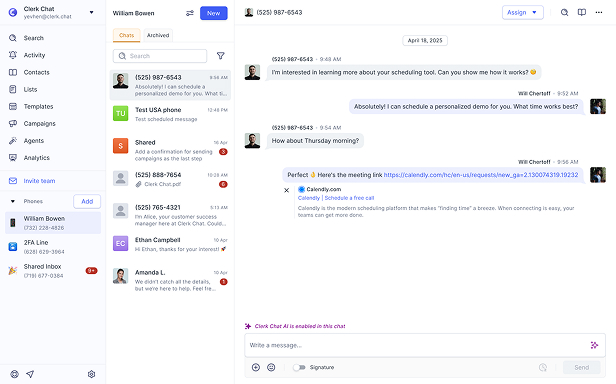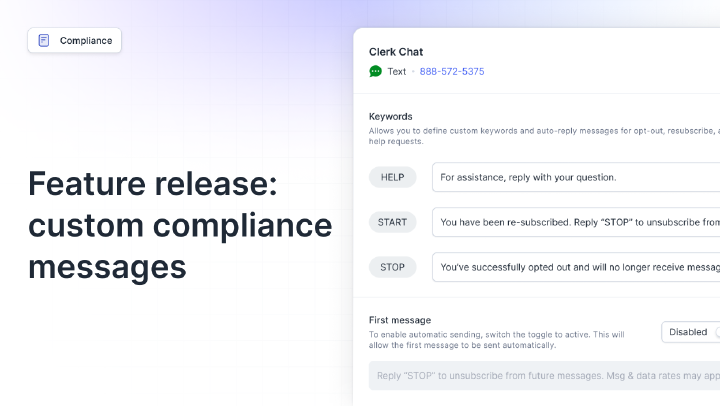10DLC
[ˈtɛn ˈdiː ˈɛl ˈsiː]10DLC (10-Digit Long Code) is a messaging standard for Application-to-Person (A2P) business texting using standard 10-digit phone numbers. It provides enhanced deliverability and compliance for commercial SMS messages sent to US mobile carriers.
See Clerk Chat in action - Book a 15-min demo
Explore how 10DLC messaging can accelerate your business outcames and camphance. Live product walkthrough on your schedule.
Why 10DLC Matters
10DLC registration has become a cornerstone of legitimate business texting in the United States. Before its implementation, businesses faced unpredictable message delivery rates and frequent filtering by carriers who couldn’t distinguish between legitimate business messages and spam. This uncertainty made SMS marketing and customer communication risky investments.
The 10DLC framework creates accountability and trust between businesses, messaging platforms, and mobile carriers. By registering your business and messaging use cases, you gain access to higher message throughput, better deliverability rates, and protection from sudden carrier blocks. This translates directly to improved customer engagement, higher conversion rates, and more reliable communication channels.
For businesses using SMS for appointment reminders, marketing campaigns, or customer support, 10DLC compliance isn’t optional—it’s the difference between messages reaching customers and disappearing into carrier filters. The system protects both businesses and consumers by reducing spam while ensuring legitimate messages reach their intended recipients.
How 10DLC Works
The 10DLC registration process involves several key steps that verify your business identity and messaging intentions:
Business Registration: Submit your company information including EIN, business type, and industry to The Campaign Registry (TCR). This creates your business profile in the carrier ecosystem.
Brand Registration: Register your brand identity, including company name, website, and contact information. Carriers use this to identify who’s sending messages.
Campaign Registration: Define each messaging use case (marketing, notifications, customer care, etc.). Include sample messages, expected volume, and opt-in methods.
Carrier Approval: Mobile carriers review your registration. Approval times vary from instant to several weeks depending on your business type and use cases.
Number Association: Link your 10-digit phone numbers to approved campaigns. Each number must be associated with registered campaigns before sending messages.
Ongoing Compliance: Monitor your messaging for opt-out requests, maintain accurate registration information, and stay within approved use cases.
The entire process typically takes 2-4 weeks for standard businesses. Some industries like healthcare or finance may require additional vetting. Once approved, your messages flow through carrier networks with priority routing and reduced filtering.
Best Practices with 10DLC
• Register early before launching campaigns - Don’t wait until you’re ready to send messages. Start the registration process at least 30 days before your planned launch to avoid delays.
• Be specific in campaign descriptions - Vague descriptions like “customer communication” often face rejection. Provide detailed use cases, sample messages, and clear opt-in processes.
• Maintain consistent messaging - Ensure your actual messages match your registered campaign types. Sending marketing content through a customer service campaign violates carrier guidelines.
• Monitor your sender reputation - Track delivery rates, opt-out rates, and spam complaints. Poor metrics can lead to reduced throughput or campaign suspension.
• Include clear opt-out instructions - Every message should include simple opt-out language like “Reply STOP to unsubscribe.” This isn’t just best practice—it’s legally required.
• Document your opt-in process - Keep records of how customers consent to receive messages. Carriers may request proof of opt-in during audits.
• Update registrations when business details change - New addresses, ownership changes, or messaging strategies require updating your 10DLC registration to maintain compliance.
Real world examples
- Retail
Major clothing retailer increased SMS conversion rates by 40% after 10DLC registration improved delivery reliability.
Read more - Healthcare
Medical practice reduced no-show appointments by 25% through compliant appointment reminder campaigns via registered 10DLC numbers.
Read more
Common misconceptions
Small businesses benefit equally from improved deliverability and actually face fewer registration requirements than large-volume senders.
10DLC improves delivery rates significantly but doesn't override recipient-level blocks, opt-outs, or carrier spam filters.
Ongoing monitoring, content compliance, and registration updates remain your responsibility even after initial approval.
Related terms
In this article:
Ready to use your business number for text messaging?
Thousands of businesses are already experiencing the power of conversational messaging through SMS. Join us. Free trial and paid tiers available.
Get StartedFAQ
Have questions? We've got answers.
Find what you need quickly and clearly with our most frequently asked questions.
Registration fees vary by provider and business type. Expect to pay a one-time brand registration fee ($4-40), monthly campaign fees ($10-15 per campaign), and per-message carrier fees ($0.002-0.005). Some messaging platforms like Clerk Chat include registration support in their service packages, simplifying the process and potentially reducing overall costs.
Unregistered numbers face severe throughput limitations (as low as 1 message per second), high filtering rates, and potential complete blocking by carriers. Your messages may not reach recipients, damaging customer relationships and wasting marketing budgets. Continued non-compliance can result in permanent number suspension and legal liability for violating carrier policies.
Yes, once your brand and campaigns are approved, you can associate multiple 10-digit phone numbers with your registered campaigns. Each number must be explicitly linked to appropriate campaigns before sending messages. This scalability makes 10DLC ideal for businesses with multiple locations or departments using different numbers for consistent messaging programs.
Standard businesses typically receive approval within 7-14 business days. Sole proprietors and certain industries (gambling, cannabis, debt collection) may experience longer review times of 3-4 weeks. Some low-risk businesses qualify for immediate approval. Having complete, accurate documentation and clear use cases significantly speeds up the process.
Yes, each distinct messaging use case requires its own campaign registration. For example, appointment reminders, marketing promotions, and account alerts need separate campaigns even if sent from the same number. This granular approach helps carriers route messages appropriately and maintains trust in the ecosystem.
Short codes (5-6 digit numbers) offer higher throughput and instant delivery but cost thousands monthly and take months to provision. 10DLC uses regular 10-digit numbers, costs significantly less, sets up faster (weeks vs. months), and provides sufficient throughput for most businesses. Short codes remain ideal for high-volume, time-sensitive campaigns, while 10DLC suits most business messaging needs.




